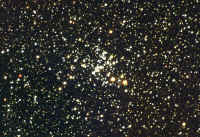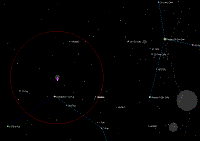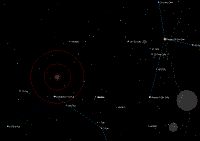M93 (open cluster in Puppis)
660: M93 image
M93 is one of the smaller open clusters, with an extent of 22 arcminutes, or about 2/3 the diameter of the full moon. Although itís small, itís relatively bright at visual magnitude 6.0. M93 is smaller and brighter than M46, although not as bright as M47. Under very dark and clear skies, M93 is a naked-eye object with averted vision for those with very good night vision.
M93 has at least 80 true members scattered over its 22 arcminute extent, with 60 or so of those visible in small scopes. M93 is triangular, with a distinct wedge or fan shape that some have described as a butterfly or a starfish. The brightest stars in M93 are blue giants, and its age has been estimated at 100 million years, which makes it middle-aged for an open cluster.
Messier discovered M93 on March 20th, 1781. M93 was one of the last objects that he found personally.
670: Monoceros, Canis Major, and Puppis Overview
Letís take another look at the area bounded by Monoceros, Canis Major, and Puppis. Note the geometry between M93 and the stars Aludra and Wezen in Canis Major. Those three objects form a right triangle, with the 4.5 degree line joining Aludra and Wezen forming the base, and the 7 degree line joining Aludra and M93 forming the vertical. As long as you keep that geometry in mind, M93 is always easy to find.
680: M93 with Binoculars
The Astronomical League rates M93 as an ďEasyĒ object with 7X50 binoculars, which indeed it is from Bullington. This slide shows a 7-degree field, which is typical for 7X or 10X binoculars. All you need do to get M93 in your binoculars is put your field in about the location shown relative to Wezen and Aludra, with Azmidiske at magnitude 3.34 about halfway from the center to the edge of the field. M93 should be nearly centered in your view, and will be visible as a moderately large nebulous patch.
690: M93 with Telrad
In order to get M93 with your Telrad, again use the right triangle of which the Wezen->Aludra line is the base. Azmidiske, at magnitude 3.34, is bright enough to be relatively prominent in the Telrad. Put it about halfway between the 2-degree and 4-degree Telrad circles in the orientation shown, and youíll find that M93 is centered in your optical finder and your eyepiece.
If your night vision is as bad as mine, 4th and even 3rd magnitude stars can sometimes be hard to see in the Telrad. If so, just put the Telrad in about the right location using large scale geometry and use your optical finder, in which Azmidiske will be very prominent, and M93 will appear as a distinct smudge about two-thirds the size of full moon.



